Geckeler K.E., Nishide H. (Eds.) Advanced Nanomaterials
Подождите немного. Документ загружается.


23.8 Technology Development Based on Biopolymer-Carbon Nanotube Products 729
from the bundles. The majority of the tubes were found to be individual, although
small bundles of two to four tubes also existed. The irregular coating seen around
the nanotube surface was the protein, as confi rmed by the detection of nitrogen
in the energy - dispersive X - ray ( EDX ) spectrum. Likewise, this confi rmed that the
nanotubes had become well dispersed in the protein solution. The AFM images
of the product showed a nanotube diameter distribution of between 1 and 5 nm,
with a majority of tubes being > 3 nm in size. Similar observations were made for
the other products. These data illustrate clearly that, during sonication, the nano-
tubes became simultaneously debundalized due to strong interactions of the
proteins with the nanotube surface, and this resulted in highly dispersed
protein – nanotube adducts in the aqueous systems. During high - speed ultracen-
trifugation, the bundled adducts were precipitated due to their higher density, and
this resulted in highly individual or less - bundalized protein – nanotubes in the
supernatant.
In order to quantify the yield and to check the effi ciency of the proteins, the
concentrations of nanotubes in the products were measured using absorbance
spectroscopy at 500 nm (Figure 23.11 ). The concentrations were calculated using
optical absorbance data fi tted to a Beer – Lambert plot. The values (which are sum-
marized in Table 23.1 ) showed clearly that the highest yield of debundalized nano-
tubes was obtained from HST at the intrinsic pH, followed by LSZ. However, the
yield was exclusively dependent on the pH. In the cases of HBA, OVB, BSA, and
MGB, the yields were much higher at basic pH. In contrast, under similar condi-
tions TPS showed a slight improvement, but for GOX the value was almost zero.
In a bid to understand these diverse phenomena, the primary structure of these
proteins was investigated. Numerous forces, including van der Waals, electro-
static, hydration, steric, hydrophobic, and chemically specifi c interactions, are
known to act between the colloidal particles in solution. Proteins serve as a rich
source of different functionalities due to the presence of different types of amino
acid residues (Table 23.2 ) and the different interactions that are responsible for
their interaction with substrates. Hence, the coordinates of these proteins were
downloaded from a protein data bank and the different types of residues present
in each sequence calculated (Table 23.3 ). For a better understanding of the major
interactions responsible for the dispersion, an attempt was made to correlate the
effi ciency of proteins for the nanotube dispersion with the residues. The correla-
tion of the debundalization degree ( DD ) of SWNTs at the intrinsic pH with respect
to percentage of hydrophobic residue s ( HR ), aromatic residue s ( ArR ), polar resi-
due s ( PR ), acidic residue s ( AcR ), basic residue s ( BR ), and charged residue s ( CR )
contained in each protein is shown as a three - dimensional plot in Figure 23.12 .
23.8
Technology Development Based on Biopolymer - Carbon Nanotube Products
A variety of novel materials has been developed by combining biopolymers with
nanotubes. Some important contributions of these materials are outlined in the
following sections.
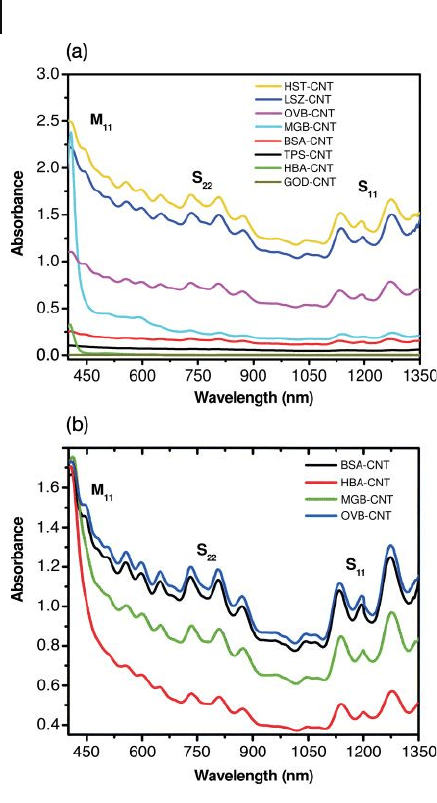
730 23 Interactions of Carbon Nanotubes with Biomolecules: Advances and Challenges
Figure 23.11 NIR absorbance spectra of the SWNT adducts
with different proteins at (a) intrinsic pH, and (b) basic pH.
At basic pH, the enhanced intensity of the nanotubes
confi rmed the high yield of nanotubes in the products. S
11
and
S
22
correspond to the fi rst and second interband transitions of
semiconducting nanotubes; M
11
corresponds to the fi rst
transition of metallic nanotubes.
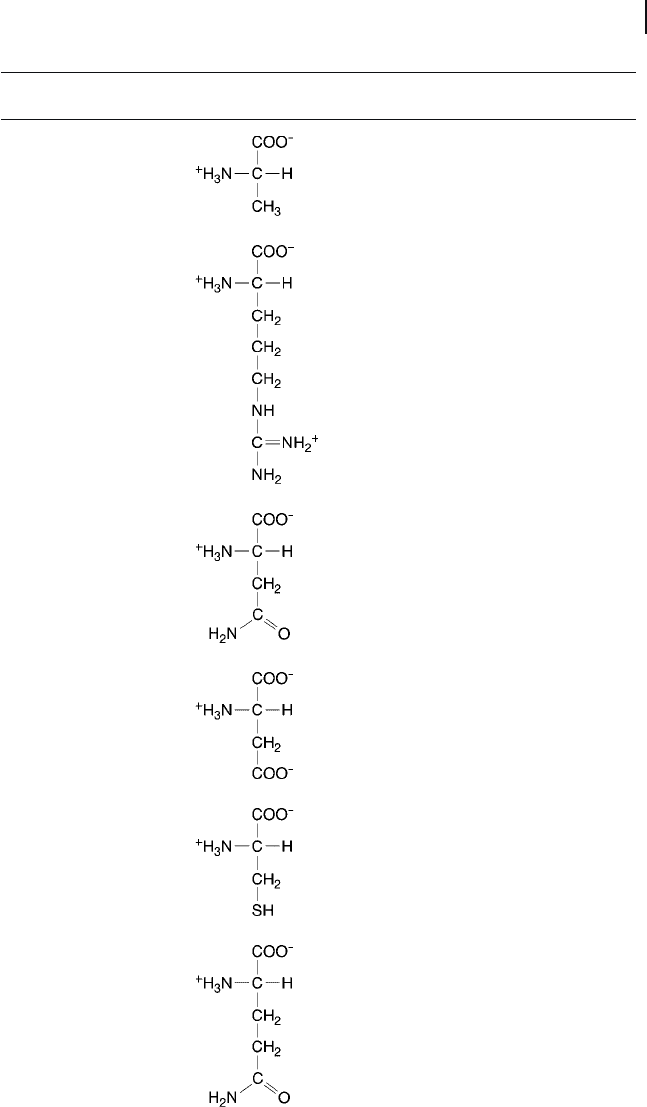
23.8 Technology Development Based on Biopolymer-Carbon Nanotube Products 731
Table 23.2 Amino acid residues and their basic chemical and physical parameters.
Amino Acid Symbol Structure Type(s)
Isoelectric point
a
Alanine A, Ala
Hydrophobic 6.01
Arginine R, Arg
Basic Hydrophilic
Polar
10.76
Asparagine N, Asn
Hydrophilic
Polar
5.41
Aspartic acid D, Asp
Acidic
Polar
Hydrophilic
2.85
Cysteine C, Cys
Hydrophobic
Nonpolar
5.05
Glutamine Q, Gln
Hydrophilic
Polar
5.65
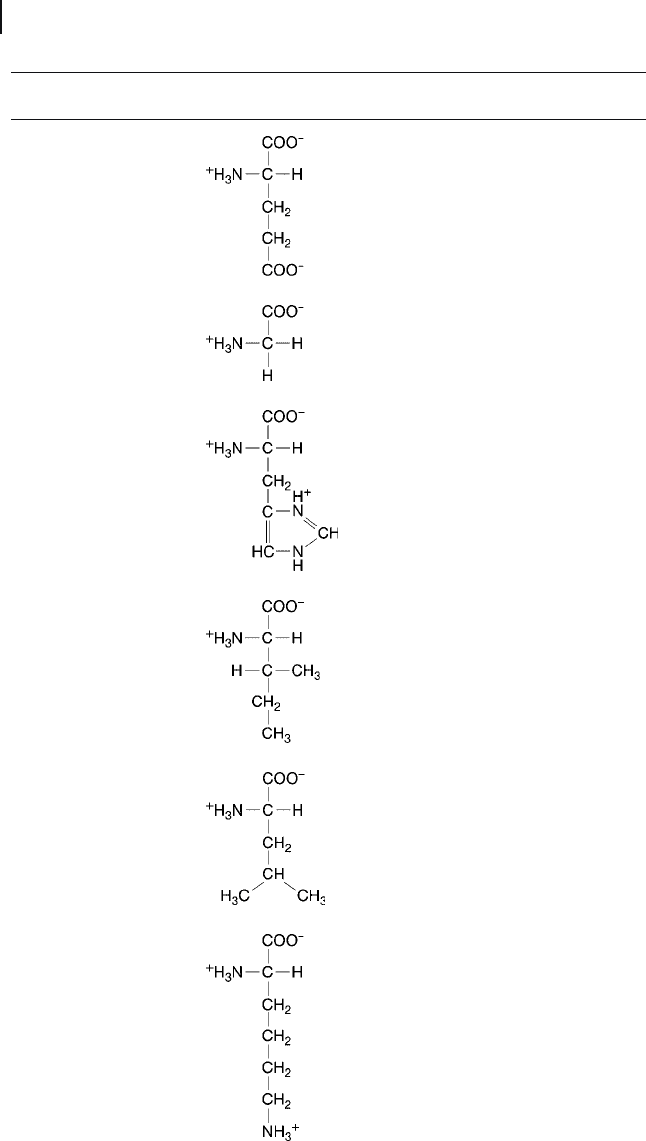
732 23 Interactions of Carbon Nanotubes with Biomolecules: Advances and Challenges
Amino Acid Symbol Structure Type(s)
Isoelectric point
a
Glutamic acid E, Glu
Acidic
Hydrophilic
Polar
3.15
Glycine G, Gly
Hydrophobic 6.06
Histidine H, His
Basic
Hydrophilic
Polar
7.60
Isoleucine I, Ile
Hydrophobic 6.05
Leucine L, Leu
Hydrophobic 6.01
Lysine K, Lys
Basic
Hydrophilic
Polar
9.60
Table 23.2 Continued.
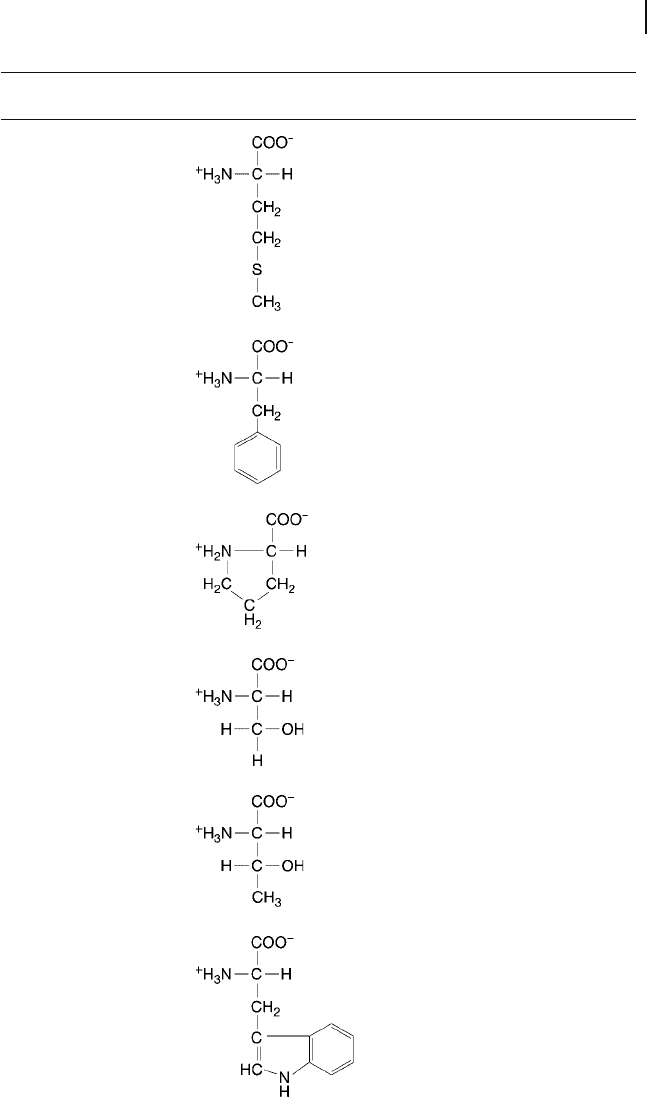
23.8 Technology Development Based on Biopolymer-Carbon Nanotube Products 733
Amino Acid Symbol Structure Type(s)
Isoelectric point
a
Methionine M, Met
Hydrophobic
Nonpolar
5.74
Phenylalanine F, Phe
Hydrophobic
Aromatic
Nonpolar
5.49
Proline P, Pro
Hydrophobic
Nonpolar
6.30
Serine S, Ser
Hydrophilic
Polar
5.68
Threonine T, Thr
Hydrophilic
Polar
5.60
Tryptophan W, Trp
Hydrophobic
Aromatic
Nonpolar
5.89
Table 23.2 Continued.

734 23 Interactions of Carbon Nanotubes with Biomolecules: Advances and Challenges
Amino Acid Symbol Structure Type(s)
Isoelectric point
a
Tyrosine Y, Tyr
Aromatic
Polar
Hydrophilic
5.64
Valine V, Val
Hydrophobic 6.00
a http://en.wikipedia.org/wiki/Amino_acid ; Doolittle, R.F. (1989) Redundancies in protein
sequences, in Predictions of Protein Structure and the Principles of Protein Conformation (G.D.
Fasman, ed.) Plenum Press, New York, pp. 599 – 623; Nelson, D.L. and Cox, M.M. (2000)
Lehninger, Principles of Biochemistry , 3rd ed., Worth Publishers.
Table 23.2
Continued.
Table 23.3 Calculation of different types of residue content in different proteins.
Protein Hydrophobic
residue (V, I,
L, M, F, W, C)
Aromatic
residue
(F, W, Y, H)
Basic residue
(R, K, H)
Acidic
residue
(E, D)
Charged
residue
(R, K, E, D)
Polar residue
(R, K, D, E,
N, Q)
HST 28.9 2.8 23.1 17.3 39 39
LSZ 30.4 10.1 14 7 20.2 33.4
OVB 34.5 10.4 10.9 12.1 21.2 29.5
MGB 28.8 13.1 19.6 14.4 28.1 34.7
HBA 31.5 14.9 16.4 9.4 19.2 24.1
BSA 31.5 11.7 17 16.3 30.5 36.1
TPS 30 10.3 9 5.3 12.5 23.2
GOD 28.2 12.6 9.6 11 17.3 26.6
23.8.1
Diameter - or Chirality - Based Separation of Carbon Nanotubes
Another very important challenge remaining in nanotube research is the separa-
tion of nanotubes based on their electronic properties. This is feasible because,
during the synthesis of nanotubes (notably of SWNTs) they may be semi - conduct-
ing, semi - metallic, or metallic, depending on the rolling vector. However, none of
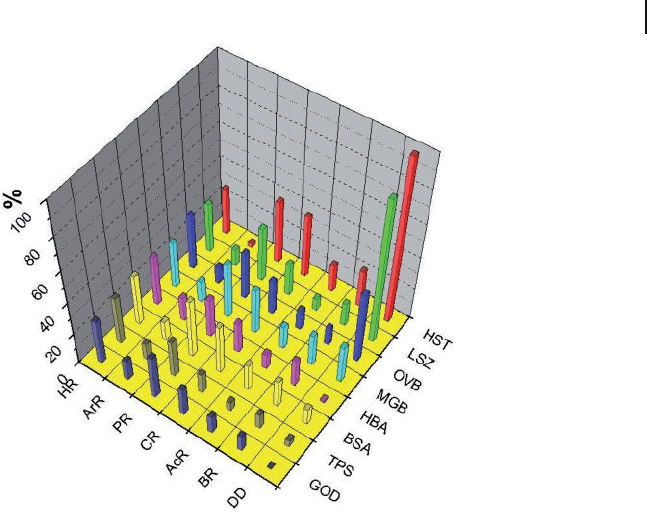
23.8 Technology Development Based on Biopolymer-Carbon Nanotube Products 735
the synthetic techniques reported to date can be used produce a single type of
SWNT; rather, a heterogeneous mixture of SWNTs is usually obtained. More
importantly, as the electrical and optical properties depend heavily on the chirality
and diameter of the nanotubes, a separation of these tubes according to type is a
prerequisite for further development of the technology. For example, when fabri-
cating optical devices based on photoluminescence, sem - SWNTs are essential, but
the presence of met - SWNTs leads to a quenching of these properties. Moreover,
the problem is worsened due to the nature of nanotubes remaining in aggregation
or bundalization, based on the strong van der Waals interactions of the parallel
tubes. Although efforts have been made to overcome this problem, an effective
and simple technique, which preferably could easily be scaled up, has yet to be
developed. One of the major achievements when using DNA for the dispersion of
nanotubes is its property to separate the nanotubes selectively, based on their
electronic properties [47] . Different experiments have confi rmed that the DNA -
based approach using chromatography (both, ion - exchange and size exclusion) is
highly effective for metal/semiconducting CNT separations, and single - chirality
CNT enrichment for certain small - diameter tubes. Such separation is possible due
to the selective interaction ability of the designed polynucleotide being synthesized
with a specifi c sequence. For example, an improved metal/semiconductor separa-
tion was possible with shorter (guanine/thymine)
n
sequences.
Figure 23.12 Three - dimensional plot showing the
debundalization degree ( DD ) with respect to the percentage
of hydrophobic residue s ( HR ), aromatic residue s ( ArR ), polar
residue s ( PR ), charged residue s ( CR ), acidic residue s ( AcR ),
and basic residue s ( BR ) contained in each protein.

736 23 Interactions of Carbon Nanotubes with Biomolecules: Advances and Challenges
By taking advantage of natural proteins under controlled conditions, it was
possible to obtain metallic - enriched nanotubes in the fi nal products, which
ranged from ∼ 33% (pristine nanotubes) to ∼ 63% (fi nal product) (Table 23.4 ).
This unique and simple technique to enrich metallic nanotubes has had
a major impact on metallic - semiconducting nanotube separation in bulk, on a
large scale.
23.8.2
Fibers
Recently, DNA - dispersed nanotube products have been used to sort nanotubes
based on chirality [30] , to synthesize polymers [54] , as well as serving as tem-
plates for nanoparticles [55] . In addition, these products have been shown to
prepare liquid crystals [56] , fi bers [57] , and coatings [20] . Whilst the future pros-
Table 23.4 Enrichment factors of metallic ( met - SWNT s ) and
semiconducting ( sem - SWNT s ) single - wall carbon nanotubes
( SWNT s ) of small and large diameters in the products using
the 532 nm and 632.8 nm Raman excitation laser lines.
Product
Enrichment factor
a
met:sem
a
(met)
s
b
(met)
L
c
(sem)
s
c
(sem)
L
b
BSA - SWNT
d
1.71 1.31 0.44 1.09 1.08 : 1
HBA - SWNT
e
1.42 1.31 0.53 1.23 1.68 : 2
HBA - SWNT
d
1.24 1.54 0.5 1.55 1.57 : 2
HST - SWNT
f
1.74 1.08 0.47 1 1 : 1
LSZ - SWNT
e
1.45 1.62 0.34 1.36 1.12 : 1
LSZ - SWNT
f
1.63 2.38 0.34 1.09 1.61 : 1
MGB - SWNT
e
1.47 1.38 0.41 1.18 1.06 : 1
MGB - SWNT
f
1.53 1.62 0.5 1.23 1.01 : 1
MGB - SWNT
d
1.55 1 0.47 1.14 1.71 : 2
OVB - SWNT
f
1.68 1.46 0.38 1.09 1.23 : 1
OVB - SWNT
d
1.71 1.39 0.5 1.14 1.01 : 1
TRP - SWNT
d
1.34 2 0.63 1 1.04 : 1
a Calculated according to the method of Samsonidze, G.G., Chou, S.G., Santos, A.P. et al .
(2004) Appl. Physics Lett . 85 (6), 1006 – 1008. ( met )
s
= small diameter metallic SWNTs;
( met )
L
= large diameter metallic SWNTs; (sem)
s
= small diameter semiconducting SWNTs;
(sem)
L
= large diameter semiconducting SWNTs.
b Calculated from 633 nm laser.
c Calculated from 532 nm laser.
d Basic pH.
e Acidic pH.
f Intrinsic pH.

23.8 Technology Development Based on Biopolymer-Carbon Nanotube Products 737
pects of CNTs in biomedical research continue to rise, the preparation of CNT -
based biofi bers has been introduced only recently [57 – 60] . DNA - based SWNT
fi bers were fi rst produced via wet spinning using poly(vinyl alcohol) in the coag-
ulation bath [57] , this being possible only due to the excellent dispersion ability
of DNA for the SWNTs. Typically, a concentration of 1 wt% SWNTs was able to
disperse very well in 1 wt% salmon DNA, which made it feasible to produce
DNA – SWNT fi bers via wet spinning. Of note, this is almost impossible using
surfactants, where ratios of surfactant to SWNTs of at least 2 : 1 [61] or 3 : 1 [62]
are necessary. The fi bers exhibited excellent mechanical properties, with a
Young ’ s modulus of up to 14 – 19 GPa – much higher than for the fi bers obtained
using sodium dodecyl sulfate (5 GPa), one of the most commonly used sur-
factants for CNT dispersion. Recently, other fi bers based on heparin – SWNT,
chitosan – SWNT, and hyaluronic acid – SWNT fi bers have also been processed
[58] . In this way, the unique nature of each of these biopolymers, and its effect
on the CNTs, may open wide possibilities for future exploration. Indeed, com-
bining the excellent conductivity and mechanical strength of CNTs with the
inherent properties of different biomolecules might one day bring about new
and exciting products.
23.8.3
Sensors
The size - dependent properties of nanomaterials have made them attractive for the
development of highly sensitive sensors and detection systems. This is especially
the case in the biological sciences, where the effi ciency of a detection system is
refl ected by the size of the detector and the amount of sample required for detec-
tion. In this respect, CNTs hold much promise due to their typical size, which
offers a great potential for enhancing the sensitivity of detection and diagnostics,
while reducing the sample size (which may consist of a few individual proteins
and antibodies). As carbon atoms dominate the surface of the SWNTs, the binding
of proteins or antibodies to their surfaces can alter the surface state, and this in
turn may result in a varied electrical and optical functionality. DNA - coated CNTs
have a great potential in the design of a variety of sensors, and several research
groups are currently working on this direction with electrochemical sensors [63] .
In addition, protein - or DNA - incorporated CNTs can be used as a base for detecting
biological surface reactions in a single protein or antibody attached to the CNT
surface.
The other main advantages of nanotubes include their optical activity, as long
as they are neither aggregated nor chemically altered. Under appropriate condi-
tions, semiconducting SWNTs show a bandgap fl uorescent emission in the NIR
spectral region at wavelengths characteristic of their specifi c (n,m) - structure. As
natural biomolecules are relatively transparent and nonemissive in this range, the
sharp spectra of SWNTs can be detected even in a complex biological environment.
By taking advantage of these properties different sensors have been designed,
including those used to detect glucose [15] .

738 23 Interactions of Carbon Nanotubes with Biomolecules: Advances and Challenges
23.8.4
Therapeutic Agents
Today, functionalized CNTs are emerging as a new family of nanovectors for the
delivery of different types of therapeutic molecules. A recent study proved that
functionalized CNTs can penetrate into cells, with the CNTs being loaded with
bioactive molecules via stable covalent bonds or supramolecular assemblies based
on noncovalent interactions. When the cargos have been carried into the different
cells, tissues, and organs, they are able to express their biological function.
Recently, Cheruki and coworkers [64] injected debundled, chemically pristine
SWNTs into rabbits and monitored their characteristic NIR fl uorescence. The
nanotube concentration in the blood serum decreased exponentially, with a half -
life of 1 h.
The ability of CNTs to convert NIR light into heat provides an opportunity to
create a new generation of immunoconjugates for cancer phototherapy, with high
performance and effi cacy. The fact that biological tissue is relatively transparent
to NIR suggests that targeting CNTs to tumor cells, followed by noninvasive
exposure to NIR light, would cause tumor ablation within the range of accessibil-
ity of the NIR light. Recently, it was shown that antibody - functionalized SWNTs
operated very effi ciently to kill targeted tumor cells [65] , this being achieved by a
specifi c binding of antibody - coupled CNTs to tumor cells in vitro , followed by their
highly specifi c ablation with NIR light. For this, biotinylated polar lipids were used
to prepare the stable, biocompatible, and noncytotoxic CNT dispersions that were
then attached to antibodies. Following exposure to NIR light, the CNT – antibody
construct was shown to have killed the targeted cells with great specifi city [65] .
23.9
Conclusions
The functionalization of nanotubes with biopolymers has achieved good progress
in a relatively short time. When compared to the programmed properties and
functions they possess in a natural environment, the technological development
achieved to date remains in its infancy. It may be premature at this stage to claim
advancements of the different fi elds using these materials, and especially for the
biotechnological sector, where issues of toxicity have not yet been fully resolved.
Nonetheless, the vast potential for these materials will surely offer rapid research
and development in this direction. There is also no doubt in anticipating that this
fi eld will bring future breakthroughs for the advancement of humankind.
Acknowledgments
This work was supported by the Ministry of Education ( “ Brain Korea 21 ” project)
and a grant from the Institute of Medical System Engineering at GIST.
